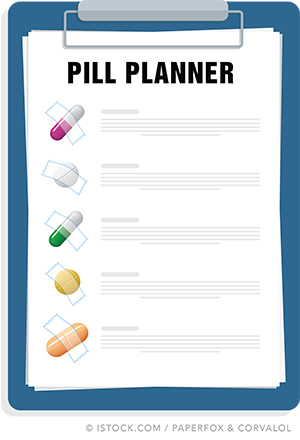
Fam Pract Manag. 2023;30(2):36
HELP PATIENTS MAKE A PILL PLANNER “CHEAT SHEET”

Many patients use a pill planner box or container with separate compartments for each day of the week. However, it may be difficult to identify particular medications once they've been taken out of their prescription bottles and placed in each compartment, particularly if the pills/tablets/capsules look similar. This could be dangerous if medications need to be taken at different times of day, or if patients accidentally spill the contents, leaving a pile of mixed-up, unsorted pills that could be difficult to identify and place back in the planner correctly.
One solution is to use a pill planner “cheat sheet.” This is a simple table, written or printed out on paper, that lists the drug name and dose for each pill, identifying marks, how and when to take it, what it is for, and other notes.
Attach one of each pill next to its name on the cheat sheet with clear tape, so patients can easily match it to the visual appearance of a loose pill. The taped-on pill need not be wasted — it can be taken last.
EVALUATE YOUR PANEL SIZE
Having an overloaded patient panel can leave physicians and patients dissatisfied, so it's worth taking time periodically to evaluate the size of your panel.
In a 2020 survey of AAFP members, the average panel was 2,085 patients.1 However, the ideal panel size will vary depending on physician, patient, and system traits.
One rubric for evaluating panel size is to use three variables: total panel size adjusted for number of clinic sessions per week, days until third next available appointment, and specialty-specific relative value unit (RVU) productivity percentile. Determine the current range for each variable within your group, and divide the range into thirds. Then, determine if your individual numbers are “low,” “medium,” or “high.”
Here's how these ranges looked for one practice:2
For adjusted panel size, 1,500 patients or fewer was low, 1,501 to 1,899 was medium, and 1,900 or greater was high.
For days until third next available appointment, 20 days or less was low, 21 to 29 was medium, and 30 or more was high.
For productivity percentile, less than 50th percentile was low, 50th to 60th percentile was medium, and greater than 60th percentile was high.
If two out of three are “low,” assume your panel size is low; if two of three are “medium,” assume your panel size is medium; and if two of three are “high,” assume your panel size is high. (For more on this topic, see FPM's panel management articles.)
USE MOCK VACCINATION AND RELAXATION TECHNIQUES TO ADDRESS NEEDLE PHOBIA
Needle phobia is a common problem that complicates routine immunization, especially for young patients. One solution is to build patients' confidence by practicing with an acupuncture needle within a plastic guide tube. (Patients who cannot tolerate even the small acupuncture needle can start with just the tube.) This strategy worked for an 11-year-old patient in our practice who developed needle phobia after observing his father's cancer treatments. After three visits, he successfully underwent voluntary COVID-19 vaccination.
To help the patient recognize his physiologic stress response and calm his autonomic nervous system, we also taught him several techniques: aromatherapy, diaphragmatic breathing, and progressive muscle relaxation. We also discussed with him the consequences of infectious disease and explained how vaccines work.
We believe this compassionate, comprehensive approach was key to addressing the patient's vaccine hesitancy, and we hope it can be useful to other primary care physicians.
